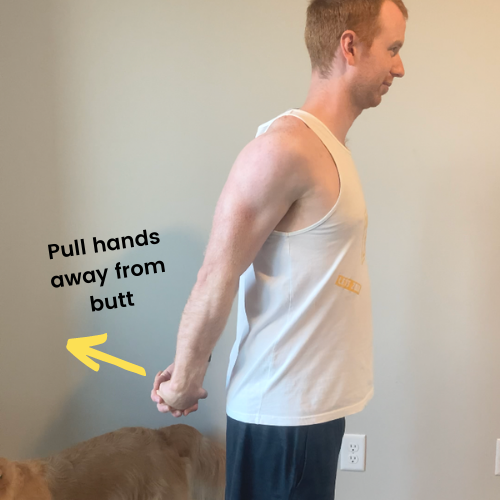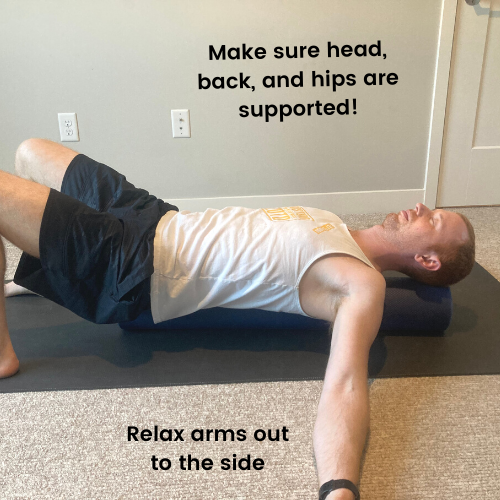Beginner-Friendly Chest Stretches for Tight Pecs
Beginner-Friendly Chest Stretches for Tight Pecs
Whether you’ve got tight pecs from bench pressing your life away at the gym, or from slouchy shoulders-forward posture that keeps your chest muscles in a perpetually shortened position - stretching them out will not only feel good, it’ll help ensure your shoulders and back stay healthy long-term.
Tight pecs can be a symptom of crappy posture, but also perpetuate crappy posture over time (leading to back pain). Tight pecs pull your shoulders forward, rounding your upper back beyond it’s normal curve, leading to back and neck pain (think of the classic “little old lady” slouch: rounded shoulders, hunched back - not terribly comfortable!). They can also make movements like reaching your arms overhead more difficult, as weightlifters, handbalancers, and yogis can attest!
Below are some of my favorite chest stretches for beginners with tight pecs. Shoutout to Nate for modeling these (thank you!) - Nate lifts weights and rock climbs regularly, and is a pretty good example of “average” (aka not crazy bendy) flexibility.
As always, if you are trying to increase your flexibility, you should make sure you are warmed up before stretching. And listen to your body - stretching should never hurt (“comfortably uncomfortable” = OK, sharp pain = not OK).
1. Against the Wall
Optional addition: ponder your existential dread
Start standing near a wall, bend your elbow and place your elbow, forearm and palm on the wall, with your elbow at about shoulder height
Twist your chest away from the wall until you feel a stretch through your chest
Hold for 20-30 seconds, then switch sides
If you feel any pain in your shoulder or elbow, or if your fingers feel “tingly” - stop. (And that advice goes for any stretching you do!). Ease up on the stretch, try sliding your elbow up or down the wall an inch, and see if that helps. If your fingers are feeling tingly, that’s usually a sign you’re pinching a nerve and pushing yourself too hard. Ease up and try a gentler stretch.
2. “The Doorway Stretch”
Start standing in (or slightly behind) an open doorway, with hands braced against the outside of the doorway at about face height, elbows bent
Leaning forwards (or taking a small step forwards), start to reach your chest forwards until you feel a stretch in your chest. Keep your back flat (don’t arch) as you’re leaning into the stretch
Hold for 15-30 seconds
Variation: Play with Hand Height. Change the height of your hands to adjust the stretch if needed. See how different the stretch feels with reaching your hands up above your head (so your bent elbows are slightly above the height of your shoulders) vs. bringing your hands down lower to shoulder height (so your bent elbows are even lower, maybe even coming in towards your ribs). I like to do this stretch with my hands at 3 or 4 different heights (even if it’s just a 10 second hold in each), to help stretch my pecs at slightly different angles.
3. Elbow Butterflies
Start with your hands behind your head, elbows bent
Start pulling your elbows backwards until you start to feel a stretch across your chest. Keep your head up (avoid letting your chin tuck and neck round)
Hold the stretch for a second, then relax and let your elbows close a little towards your face (just enough to let the stretch go, you don’t have to hug them all the way together)
Repeat for 8-12 reps
[Optional] hold the last stretch for a slow count of 10 for a deeper/longer stretch
4. Towel Stretch
Start standing, holding a towel or a strap behind your back down by your butt
Grab the towel with both hands, palms facing away from your butt (thumbs pointing in towards each other)
Keep your arms straight as you lift your hands up and away from your butt until you start to feel a stretch across the front of your chest and shoulders
Hold for 10-20 seconds
Want to make it easier? Instead of trying to hold the stretch for a long hold, do some slow stretch reps: pull your arms away and hold the stretch for a second or so, then relax. Repeat 8-12 times (bonus points if you do try to hold the last rep for longer).
Want to make it harder? Instead of keeping your palms facing away from your butt, rotate your arms so your palms are facing in towards each other (thumbs towards your butt), or try to interlace your fingers instead of holding a strap.
5. Lying on a Foam Roller
This one is my favorite because you really get to relax into the stretch.
Lie down the long way on a foam roller: hips, spine, and back of your head supported by the roller. You can keep your knees bent and feet flat on the floor for balance
If you only have a short foam roller, you can use a yoga block under your hips and/or head for support, and the foam roller between your shoulder blades. Ideally you want your hips, back, and head all supported at about the same height to make this the most comfortable
Open up your arms out to the side, palms facing up towards the ceiling, letting gravity pull your arms down, giving you a gentle chest stretch. Feel free to bend your elbows, or straighten your arms, to see which feels like a more comfortable stretch
Hang out here for 20-30 seconds (or longer if this is really your jam)
6. Snow Angels
Start lying on a foam roller (like above), and slowly sweep your arms like you’re making a snow angel: keeping your arms heavy and relaxed, slowly drag your arms up like you’re going to reach overhead, and then drag them down like you’re reaching down toward your hips, trying to keep your arms as relaxed as you can the whole time.
You can also do this one lying flat on the floor (without a foam roller), but the foam roller helps gravity pull your arms out into a deeper chest stretch.










